Ningxia Facts
Chinese Name: 宁夏回族自治区 (níng xià huí zú zì zhì qū)
Abbreviation: Ning
Population: 6,946,600
Area: 66,400 square kilometers (25,637 square miles)
Location: in the northwest of China
Administrative Division: 5 cities (Yinchuan, Shizuishan, Wuzhong, Guyuan, Zhongwei); 22 counties and county-level cities
GDP (2019): CNY 374.848 billion (USD 54.334 billion)
Nationalities: Han, Hui, Uygur, Dongxiang, Kazak, Salar, Bonan
Home to the Largest Hui Community in China
Ningxia can be found on the map in northwest China and in the middle and lower reaches of the Yellow River. It is bordered by Gansu to the south, Shaanxi to the east, and the Inner Mongolia Autonomous Region to the north, and it is one of the five ethnic minority autonomous regions in China.
The Hui population accounts for about one-third of the total population of the autonomous region. Mosques of all sizes are everywhere in Ningxia and Eid al Fitr is regarded as the most important festival.
Known as a green and beautiful land in northwestern China, Ningxia was involved in a part of the ancient Silk Road, being a platform for trade and cultural exchanges between China's central regions and northwestern areas. Ningxia tourism mainly consists of natural reserves, majestic desert scenery, attractions along or around the Yellow River and relics of the mysterious Western Xia Dynasty (1038 - 1227).
Cities in Ningxia
History
Ningxia, a region as culturally rich as the entire area south of the Yangtze River, continues to be admired for its resplendent cultural heritage garnered from the long river of history. During the time of the Tang and Han Dynasties (206 BC - 907 AD) Ningxia was the main place for trade and transportation between the eastern and western regions of ancient China. Ruins of the Great Wall of the Ming Dynasty can be found in its east region.
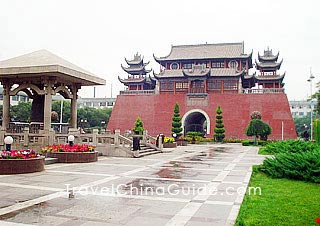 |
| Yinchuan City Center |
What to See
A unique landscape, unique local customs and habits, and ancient history, all add up to make Ningxia an interesting tourist area for those wishing to discover a rich and diverse region.
Yinchuan City (also called 'Phoenix City') is the capital of the region situated in the remote northwest of China. The 1000-year-old city is a famous cultural city beyond the Great Wall. The old sector of Yinchuan City to the west is green and peaceful, and contains all the places of interest. It includes the 1500-year-old Haibao Pagoda; the famous Buddhist architecture from the West Xia Kingdom Pagoda of Chengtian Temple; and the Western Xia Imperial Tombs known as the 'Pyramids of China'. One can also find there the mystic Helan Mountain Rock Painting, created by the ancient nomads who dwelled in the regions of the Helan Mountains in northwest Ningxia. They used a bold and descriptive chiseling and drawing technique, to which they added dazzling colors, to depict the history of a splendid Chinese civilization.
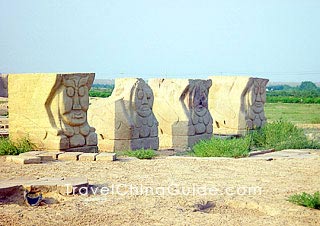 | | West Xia Imperial Tombs | | 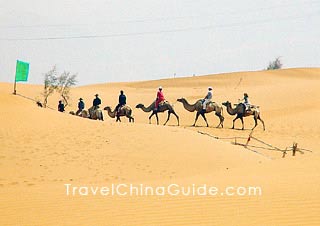 | | Camel riding in desert, Yinchuan | |
Liupan Mountain is located in south Ningxia. This is an area famous for its picturesque scenery and it certainly lives up to its reputation as the 'green islet'.
Sand Lake Scenic Resort is the national tourist trump card for those looking for a place with a lake, sand dunes, reeds, birds and fish. During the May-September period, the lake becomes a veritable paradise for a dozen or so varieties of precious bird species, such as swans, white and grey cranes, black storks, and wild geese.
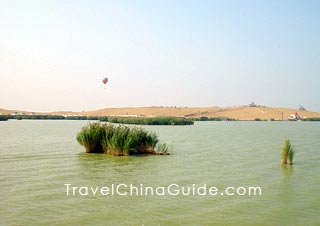 | | Sand Lake, Yinchuan | | 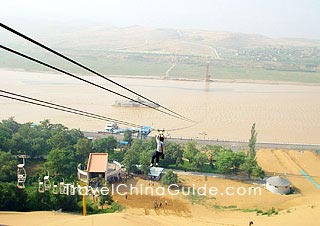 | | Shapotou, Yinchuan | |
Shapotou on the southern rim of the Tengger Desert: There one will find the Desert Research Centre, established in 1956 to find ways of preventing the sands from encroaching onto the railways, and one of China's four singing sand dunes. Sliding down the sand dune gives one the ethereal feeling of descending from the sky. The peculiar geological structure of the place causes the sand to emit a resonance that reverberates like the tolling of a huge bell or the beating of a big drum. Limpid water flows gently in a knee-deep stream at the foot of the dune.
Ningxia is the home of Chinese Muslems. When you go, please be respectful of the unique local customs and habits of the Hui people.
- Last updated on Jul. 22, 2024 by Brenda Lian -




